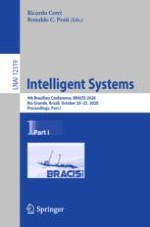2020 | OriginalPaper | Chapter
An Evolutionary Algorithm for Learning Interpretable Ensembles of Classifiers
Authors : Henry E. L. Cagnini, Alex A. Freitas, Rodrigo C. Barros
Published in: Intelligent Systems
Publisher: Springer International Publishing
Activate our intelligent search to find suitable subject content or patents.
Select sections of text to find matching patents with Artificial Intelligence. powered by
Select sections of text to find additional relevant content using AI-assisted search. powered by
